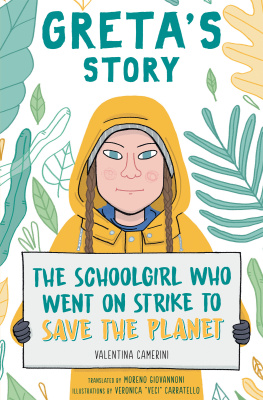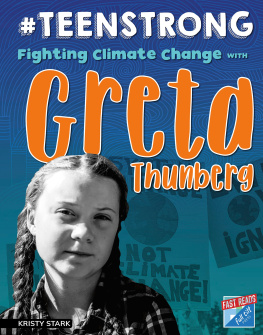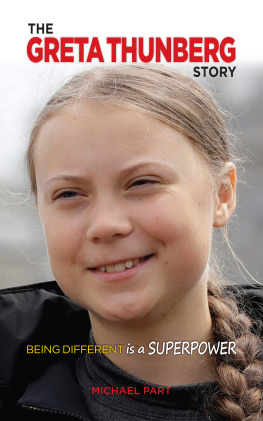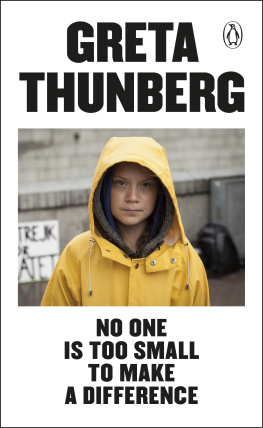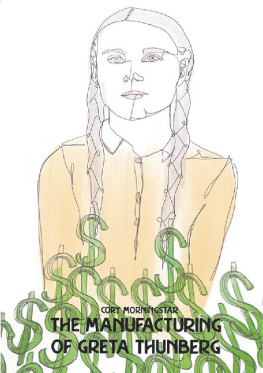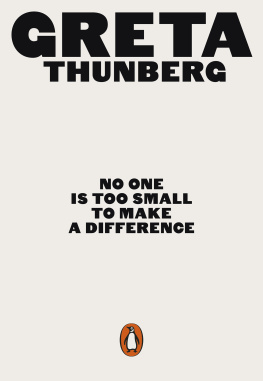GRETA THUNBERG is 15 years old and has an idea: things need to change in order to save the environment. In just a few months, she manages to involve millions of people, ordinary and powerful, in doing just that, drawing everyones attention to the health of our planet.
With her courage and determination, Greta showed that all of us can do something practical to tackle even the toughest issues. Or, as she herself said: You are never too small to make a difference.

O ne August morning in Stockholm, Sweden, Greta Thunberg decided she could no longer ignore the problems facing the planet. Changes to the climate were more and more worrying and it seemed as if no-one was taking the problem seriously.
In parliaments all over the world, tens of thousands of serious-looking and stern-sounding politicians sat and talked about an endless range of issues. But they never addressed the problem of the health of the planet. It was time for someone to remind them to step in to protect the environment and the future of children all over the world. It was an emergency. Everything else could wait.
So, on that day, Greta tied her long hair into two plaits, put on a checked shirt and a blue coat, and walked out of the house where she lived with her parents. Under her arm she carried a wooden placard. Handwritten at the top were the words SKOLSTREJK FR KLIMATET (School Strike for the Climate). She had also made some leaflets to distribute, with some very important information about climate change that she thought everyone should know about.
That day, Greta, like all Swedish children her age, should have gone to school. In Sweden the holidays end in August and classes start again. Instead, she climbed on her bike and rode to the parliament building in the city centre.
The Swedish Parliament meets in a beautiful, serious-looking building that is large and imposing, on a small island with a long, complicated name in the middle of the city: Helgeandsholmen. Its not at all surprising that its on an island, because Stockholm is built on thousands of islands, some of them tiny and others so big that if you were flying over them you would think they were the mainland.
The Riksdag, which is what the Swedes call it, is the place where politicians elected by the people sit and discuss the countrys problems and pass laws to address and fix them. These are the people who can really make a difference. If they hadnt noticed that global warming had become an emergency, Greta would remind them.
Of course, in our daily life, every single one of us can commit to reducing our impact on the health of the planet by limiting waste and pollution as much as possible. But unfortunately, this is not enough. We need more than the good intentions of individual people. Faced with an issue as complex as this, you have to change the rules and make new laws to protect the environment. Who else can do this if not the men and women sitting in the parliament? Thats why Greta went there that morning.
On that day Monday the 20th of August 2018 Greta launched her school strike.
This is how she explained her thinking: Children wont do what you tell them to do, but they will follow your example. Because the adults didnt seem at all concerned about the future, she was prepared to take action. She would stop going to school. She would go on strike, like the grown-ups do when they protest for their own reasons. Instead of going to work, they decide to meet in city squares and in the streets, carrying placards and banners. The difference was that Greta was on her own and was protesting for everyones benefit.
People passing by looked at the girl with the placard and were curious about her. Perhaps they wondered who she was and what she was doing. She sat there for the time she would normally have been in class, from 8.30 in the morning until three in the afternoon. On the first day, she spent all that time by herself and none of the politicians walking past took any notice. But Greta wasnt discouraged.
The next morning, she got up early, dressed, climbed on her bike and went back to the parliament, again carrying her sign. The strike continued.
But on this second day, something incredible happened: instead of just glancing at her, wondering what she was doing there, and then walking straight past, a few of the people passing by decided to stop. Greta was no longer alone. Other boys and girls joined her.
By the third day, there was a nice little group of people sitting on the ground with her. They were mostly young, but there was also a mother with a little boy in a stroller, a woman with grey hair and a student who had brought along a book to read. The protesters chatted among themselves. The last few days of that Swedish summer were still sunny.

On the sixth day of the strike, Greta suggested to everyone that they should talk about the protest on their social networks, sharing photos and information. That way, even people who couldnt join the protesters would be able to show their support with a message, a like or a share. The news about what was going on began to spread. Of course, Greta played a big part. Every day she took photos of the skolstrejk , the school strike, keeping a diary on Instagram. Friends, schoolmates and acquaintances started asking for information: can we come too? what time will we meet you? Greta said everyone was welcome.
More and more people sat with her in front of the parliament building. They were on strike and had decided they would be late for work or school, would skip breakfast at their local cafe or not do their shopping. Day after day, the group of concerned citizens who had decided to follow her example and join the protest, confident that she was absolutely right, got bigger and bigger. They had to act to save the planet, as soon as possible and without delay.
The politicians walked past Greta on the way to their offices in the Riksdag. Although most of them continued to ignore her, occasionally someone would stop to congratulate her and tell her she was doing a great job.
Around the city, people started talking about Greta, the 15-year-old with plaits. Newspaper reporters turned up, as well as some people who were just curious, and others who wanted to show their support. More and more mothers came along with their children. There were grandparents and lots of young people. Someone brought Greta something to eat and drink.
After nine days, the protest was still continuing but the protesters had to move to Mynttorget, a lovely square on the island of Gamla Stan, in the citys historic centre. It wasnt too far from the parliament, so it was okay. Greta wanted to protest, not break the law.
Meanwhile, all over the world, people were more and more interested in what was happening in Stockholm, and a major English newspaper decided to tell Gretas story. The famous paper The Guardian published an online article about the skolstrejk fr klimatet . The headline read, The Swedish 15-year-old whos cutting class to fight the climate crisis.
Lots of people were reading about the climate strike in newspapers and thought it was a good idea. Swedes living in other big cities and small towns, from one end of Sweden to the other, heard Gretas call and organised the same kind of protest.
In Linkping, a small town in the south of the country, a group of people gathered in the town centre next to a fountain and held up a placard that was just like Gretas. A photograph of a bicycle arrived from Rome. Resting against the bikes pedals was a sign that read: THANKS GRETA! WE RE ON YOUR SIDE TOO!

